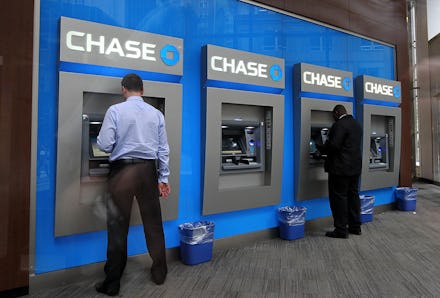Banks Are Punishing Your Wallet for Not Using Their Crappy ATMs

The news: According to a new survey by Bankrate, ATM fees are getting downright out of control. The fees, which are levied on customers when they use an ATM not owned by their bank, have jumped 5% in the past year. On average, a customers is now charged a total of $4.35 per transaction.
That means that if you want your own money, you need to pay your bank about $1.58 and the machine owner another $2.77. These might seem like relatively small penalties, but by some estimates, the average person will visit an ATM 7.4 times per month, which could translate into $32.19 per month or $386.28 per year, just to get hold of your own money. Maybe that lockbox of cash under your mattress is starting to look a bit more appealing.
The survey also notes that overdraft fees, which are charged when you try to withdraw more money than you have, rose to an average of $32.74 per year, which marks the 16th consecutive record high.
Why is this such a problem? Good question. Arguably, as a business, banks have the right to charge for their services. "If you're going to use someone else's ATM, they have a right to charge you for it," Mark Schwanhausser of Javelin Strategy & Research told Bankrate. "Is the fee appropriate? That's where you start to have a debate."
And that's exactly the issue. While using whatever ATM you can find, regardless of its ownership or affiliation, might seem like sloppy financial management, there's a certain point at which these rates become simply prohibitive. While city-dwellers may only have to walk one or two (or 20) blocks to find their own bank's ATM, others in less accessible areas could be out of luck.
But there's a bigger concern. What's more disconcerting is the way the banks seem to be toying with the average account holder. As NPR points out, since the 2008 financial crisis, lenders have been responding to a number of new restrictions on certain fees by aggressively raising others, namely overdraft and ATM fees.
Bankrate reports that according to data from the Federal Deposit Insurance Corp., commercial banks collected an astonishing $41.1 billion in fees in 2009, but that figure dropped more than 20% to $32.5 billion in 2013, partially thanks to new regulations, partially thanks to smarter financial management by their customers. To make up for these lost revenues, the banks are simply charging more in other fees, hence the insane ATM fees.
Banks are also being hit in other ways. Since the Great Recession, many Americans have been changing their spending habits by putting more money into savings and emergency funds, relying less on credit and generally racking up less debt. According to Fox Business, consumers paid down billions of dollars in debt following the recession; there was an overall decline in credit card balances in 2009 and 2010 of $136 billion, while car loans fell another $80 billion in that period. With all this happening, to put it simply, fewer loans and less debt means less money for the banks.
So as thousands of Americans have been trying to become more fiscally responsible as they deal with the reeling economy (partially caused by these very banks), banks have tried to make up their lost profits by punishing their customers with more fees at every turn. Not cool, guys.